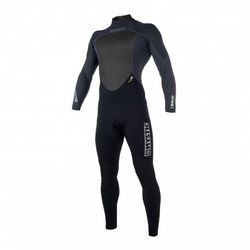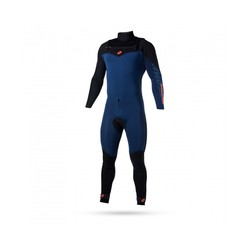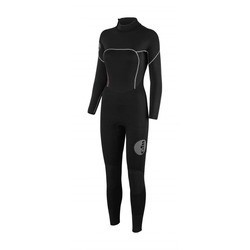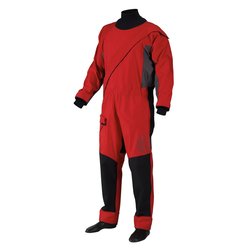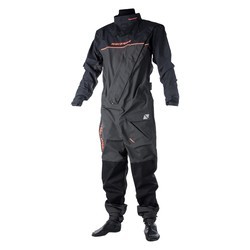How to Choose the Right Neoprene Wetsuit ?
WELL CHOOSED: the neoprene suit
Whether it is for a surfing session, a dinghy trip or for coastal longevity, the purpose of the wetsuit remains the same: to keep your body at the right temperature. Don't take the hottest wetsuit you can find as this will lead to overheating, which can be much more problematic. Note that a neoprene suit is not waterproof. It allows some water to pass through and warm up on contact with your skin, which keeps your body at a constant temperature. To enjoy a good experience in the sea, many types of neoprene suits exist, in different thicknesses and materials. The most common types of neoprene suits are drysuits, full-body suits, classic suits, long john, overknee and shorty suits.
Which wetsuit to choose according to the water temperature?
The most important point to take into account is the condition of use in which you will wear your wetsuit. The wetsuit you choose will be different depending on whether you plan to sail in winter, summer or mid-season. The water temperature varies with the season. The weather conditions specific to your location when you are in the water is also something to watch closely.
Be aware of the type of wetsuit material you choose, as this will have an impact on how you protect yourself from the weather. Models range from fully waterproof dry suits to semi-dry suits of varying neoprene thicknesses. Other suits such as lycras will simply protect you from chafing and UV rays. Note that neoprene is also useful to protect from shocks and to float better.
It is therefore necessary to choose the type of neoprene best suited to your practice in order to enjoy your outing in the sea, and avoid suffering from discomfort. Two types of neoprene exist on the market: jersey and mesh. The jersey, whose coating resembles fabric, offers flexibility, comfort and resistance. However, its protection against the wind is limited. Mesh, on the other hand, offers a smoother and more rubbery coating that will protect particularly well from the wind, but it is more fragile.
As you might expect, the best suits are made of both jersey and mesh. The jersey will give you more flexibility and resistance in the sensitive areas (legs, buttocks, arms), while thin mesh panels on the back and torso will keep the heat in.
What thickness of wetsuit to choose?
Then comes the choice of the thickness of the neoprene. It depends essentially on the water temperature in your area, which can vary, we grant you, according to the seasons. There are different thicknesses of neoprene at all the major brands. You will always find 2 or 3 digit designations. 5/4/3mm, 4/3mm, 3/2mm... When you find two numbers, the first one corresponds to the thickness of neoprene at the level of the trunk and back. The second number corresponds to the thickness of neoprene on the rest of the suit. When there are three numbers, the first number corresponds to the thickness of neoprene on the trunk, the second number to the thickness of neoprene on the arms and the third to the thickness of neoprene on the thighs. Directly after the choice of the thickness, the choice of the cut will be essential. As a reference, in Brittany, most of the time we wear 5/4/3mm all year round (and 4/3mm in summer for those who have a second wetsuit). A 4/3 can be enough in the south of France, by adding a warm top underneath (Titanium or polar). There is no predefined rule and sensitivity to cold is rather personal.
If you are used to sailing in temperate waters but you also want to enjoy your favorite sport in winter or mid-season, do not hesitate to take a thicker wetsuit. Don't think that you will be bothered by the thickness of the wetsuit, the evolutions of these last years are quite surprising and even thick wetsuits have become very flexible and light.
If you are dreading the cold, why not try a fully waterproof dry suit in which you stay dressed and dry with technical clothing. These suits, particularly suitable when temperatures drop, are equipped with waterproof seams, neck, wrist and ankle sleeves for a flawless waterproofing.
Choosing the right thickness for your neoprene suit is not easy. The first criterion to take into account is its thickness. Measured in mm, it determines the thermal insulation capacity of the wetsuit: the thicker your wetsuit, the warmer it will be.
You will notice that on many models two numbers are used to indicate the thickness. The reason is simple: the thickness of the neoprene is not the same throughout the suit. The first number indicates the thickness of the wetsuit at the chest level, the second the thickness of the limbs (arms and legs). A wetsuit is thus 2 mm thick.
If by summer temperatures a simple neoprene will be enough, it is essential to equip yourself with a full wetsuit when you are planning an outing in cold water.
Which wetsuit for my practice?
According to your practice, you will have to take into account certain important criteria:
- For surfers, it is strongly advised to choose a thinner wetsuit for the limbs. This will give you more freedom of movement when paddling and taking off.
- For dinghy sailors, we also recommend a thinner wetsuit in the limbs to facilitate maneuvers, especially when tacking.
- A will be perfectly adapted to kayaking as well as to stand up paddling, as it will give you a better freedom of movement to paddle. In case of strong heat, it will also be easier for you to roll up the top of the wetsuit.
- For scuba diving, it is better to choose a wetsuit with the same thickness over the whole body. Underwater, the body cools down 25 times faster than in the open air, so it is essential to keep a thick layer of neoprene to avoid getting cold. Moreover, the physical activity is not intense enough to warm you up, so it is important to take a thicker wetsuit than for other water activities.
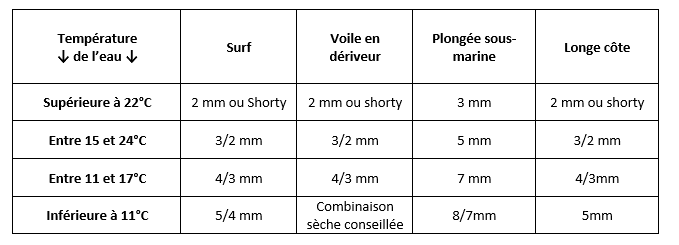
Some practical advice before you jump into the water:
- Choose a tight-fitting wetsuit
When choosing your wetsuit, make sure it fits snugly around your body. When it is dry, it is normal to feel tight, but know that this feeling will disappear when it is wet. Indeed, withhumidity, neoprene softens and you must avoid that folds form. This will create water traps that will reduce the thermal efficiency and lead to possible irritations. In most cases, your measurements will not correspond to the exact cm of the size guide, base your measurements on the chest size, then the waist size.
Quality of neoprene
The differences in price that you will notice come directly from the type of neoprene offered. We advise you to choose super stretch to have a flexible and comfortable product. Entry-level neoprene tends to cause chafing and wrinkling.
-
In very cold weather, cover your head
In very cold weather, the body loses more than 30% of its heat through the head. A tip to keep your body at temperature is to cover your head. There are several solutions for this. The most effective being the or the .
- Complementary accessories
Beyond the beanie or the hood, accessories are also very important to complete your outfit. Some will be perfect for a winter dive and short finger gloves made of fabric with reinforced palms will help you avoid injury when dinghy or kite-surfing. If your neoprene suit does not already cover your feet, we recommend the use of or to be fully protected against the cold. This applies to surfing, diving and all other water sports. You can distinguish between kitesurfing boots and booties by their shape. Booties stop at the bottom of the malleolus, while boots go up above the ankles. Whatever the function of the boot (anti-cold or protection), take it adjusted, adapted to the width of your foot. For booties, a Velcro or zipper closure helps to put them on easily. Mittens or gloves with an open palm, the choice is yours. These models are very efficient to protect from the cold wind without adding a layer on the palm. You keep the same diameter of bar in hand without tetanizing. For icy waters, it is better to use closed gloves to keep the heat in, they are less comfortable if you are not used to them because of the extra thickness between your palm and the bar.
- Think about the dry suit alternative
If you're dinghy sailing or kitesurfing in the cold, it's always worth considering the alternative. Unlike neoprene wetsuits, dry suits are waterproof, so they don't let water get inside. They are often worn with a } as an under layer and allow for better insulation against the cold. As seen previously, the body cools down much faster when it is wet, which makes the dry suit a great ally in the fight against the cold.
How to maintain my wetsuit ?
To prolong its life, a neoprene suit needs to be maintained. Always make sure that you never dry your wetsuit in the sun, as UV rays accelerate its wear. Then, only two products will be enough for its good maintenance: some and the . The disinfectant allows you to clean your wetsuit after the effort and the neoprene glue allows you to repair the small nicks that can appear with thewear of time.
In summary...
You should choose your neoprene suit according to two main criteria: the water temperature and theactivity you practice. You can refer to the summary table above on this page. Among the practical advice we can give you, the first is to choose a very tight-fitting wetsuit, which will soften when it gets wet. Then, don't hesitate to complete your protection with equipment such as gloves or booties.
If it's still cold, wear a hat, hood or even a hood because more than 30% of your body's heat loss is through the head. If you practice dinghy sailing or kite-surfing in very low temperatures, don't forget the existence of dry suits, which can meet your needs. Finally, the maintenance of neoprene is reduced to disinfectant and glue as long as you rinse it with clear water after each use and do not let it dry in the sun.
Happy surfing to all!
For any question or additional information, we are at your disposal at 04.78.41.79.31.
The Nautisports. com team





